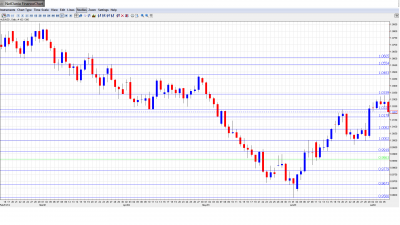The Australian dollar was almost unchanged over the week, as AUD/USD closed just above the 1.02 line, at 1.0207. The upcoming week has nine releases, including Australian employment data and several key Chinese releases. Here is an outlook for the Australian events, and an updated technical analysis for AUD/USD.
AUD/USD was in a holding pattern for most of this past week, prior to the monetary measures taken by the ECB and BOE. Australian data continues to be a mixed bag, although Building Permits and Trade Balance were both well above the market forecasts.
Updates: Job Advertisements improved, but were still in contraction mode, as the indicator fell 1.2%. Key employment data will be released later this week. Chinese CPI posted a gain of 2.2%, slightly below the market forecast of 2.4%. AUD/USD is steady, as the pair was trading at 1.0171. China posted a Trade Balance surplus of 31.7 billion, its best performance since February 2009. This news was particularly welcome after recent weak releases. NAB Business Confidence dropped to -3 points, a ten-month low. RBA Deputy Governor Philip Lowe will be addressing an economic conference in Melbourne later on Tuesday. Despite the disappointing data the aussie has strengthened, crossing above the 1.02 line. AUD/USD was trading at 1.0237. Consumer Sentiment jumped 3.7%, a five-month high. Home Loans declined sharply, posting a reading of -1.2%. The market estimate stood at 0.8%. Key employment data will be released on Thursday. The aussie continues to climb, buoyed by the strong Consumer Sentiment release. AUD/USD was trading at 1.0275. RBA Deputy Gov Philip Lowe adressed an economic conference in Sydney. MI Inflation Expectations hit 3.3%, a three-month high. The indicator is useful in predicting actual inflation trends. Employment data was a big disappointment, as 27,000 jobs were lost. The market estimate for Employment Change stood at no change. The Unemployment Rate nudged up from 5.1% to 5.2%. The aussie slumped on the weak data, as well as the news that the Federal Reserve was not planning any monetary steps. AUD/USD was trading at 1.0117.
AUD/USD graph with support and resistance lines on it. Click to enlarge:
-
ANZ Job Advertisements: Monday, 1:30. This employment indicator has been in negative territory for the past two readings. Will it rebound in July?
-
Chinese CPI: Monday, 1:30. This key inflation index has been on a recent downswing, and the markets are expecting the index to continue to drop in July, with an estimate of 2.4%.
-
NAB Business Confidence: Tuesday, 1:30. In June, the indicator sagged to an eight-month low, recording a reading of -2 points. Will the indicator rebound into positive territory in July?
-
Chinese Trade Balance: Tuesday, Tentative. This reading should be treated with caution, as the data is sometimes leaked by the media before the official release. This indicator is very important, given that China is Australia’s number one trading partner. The July forecast calls for a widening of the trade surplus, to 24.1 billion.
-
Westpac Consumer Sentiment: Wednesday, 12:30. Consumer Sentiment tends to be quite volatile, so market forecasts are often way off the mark. The indicator showed a modest gain of 0.3% in June.
-
Home Loans: Wednesday, 1:30. Home Loans have shown very little growth over the past two readings. The markets are expecting a stronger July, with an estimate of 0.9% for this month’s reading.
-
MI Inflation Expectations: Thursday, 1:00. This inflation indicator posted a reading of 2.3%, the lowest figure in over three years. This indicator is used by analysts in their forecasts for actual inflation.
-
Employment Change: Thursday, 1:30. This key indicator has posted strong figures over the past three months, with each one well above the market forecast. The markets are predicting a much lower increase in July, of only 0.3 thousand newly-employed people. The unemployment rate is expected to move up a notch to 5.2%, from the present 5.1%.
-
Chinese GDP: Friday, 2:00. GDP is expected to drop to 7.9%, from the present 8.1%. If the GDP figure is above or below the market forecast, we could see an impact on the aussie.
* All times are GMT
AUD/USD Technical Analysis
AUD/USD opened at 1.0238. The pair reached a high of 1.0329, as the resistance line of 1.0340 (discussed last week) held firm. AUD/USD then retraced, dropping to 1.0179. The pair closed the week at 1.0207.
We start with resistance just above the round figure of 1.06, at 1.0605. This is followed by resistance at 1.0557, which has held firm since May 2011. Next, the line of 1.0482 is providing resistance. This line has held firm since March. Below, there is resistance just above the 1.04 line, at 1.0402. This line saw a lot of movement before the aussie’s sharp slide in May. Close by, 1.0340 is the next line of resistance. This line held firm as the Australian dollar showed some strength before retracing. Below, resistance at 1.0230 was breached this week, but is still providing the pair with weak resistance. This line could face further testing if the aussie rebounds upwards.
Close by, 1.0174 continues to provide the pair with weak support, as the line held firm against the piar’s brief downward push. Below, there is support at 1.0080. Next, is the psychologically important parity level, which saw action in June. The next support level is 0.9917, which has strengthened as the pair contrinues to trade above the 1.02 line. Next, there is support at 0.9860. This is followed by 0.9780, which has held firm since last November.
The next support line is 0.9668. This is followed by support at 0.9580. Since dropping to this level in the first week of June, AUD/USD has rebounded in impressive fashion. The final support line for now is just above the 0.94 level, at 0.9405.
I am neutral on AUD/USD.
The Australian dollar has looked sharp, gaining around six cents since the first week of June. However, traders should keep in mind that the aussie had an even steeper loss in May, underscoring its reputation as a volatile currency. Australia continues to suffer from the global slowdown, but there have been some bright spots in the Australian economy. Further positive economic releases could bolster the Australian dollar.
The Aussie sometimes moves in tandem with gold. You can trade binary options on gold using this technical analysis.
Further reading:
- For a broad view of all the week’s major events worldwide, read the USD outlook.
- For EUR/USD, check out the Euro to Dollar forecast.
- For the Japanese yen, read the USD/JPY forecast.
- For GBP/USD (cable), look into the British Pound forecast.
- For the Australian dollar (Aussie), check out the AUD to USD forecast.
- For the New Zealand dollar (kiwi), read the NZD forecast.
- For USD/CAD (loonie), check out the Canadian dollar forecast.

